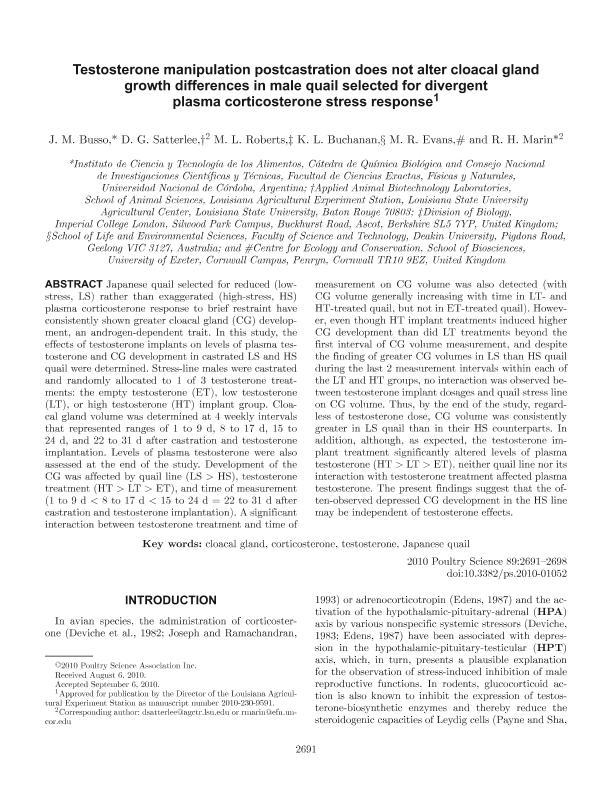Mostrar el registro sencillo del ítem
dc.contributor.author
Busso, Juan Manuel

dc.contributor.author
Satterlee, Daniel G.
dc.contributor.author
Roberts, Mark L.
dc.contributor.author
Buchanan, Katherine L.
dc.contributor.author
Evans, Matthew R.
dc.contributor.author
Marin, Raul Hector

dc.date.available
2018-07-25T19:43:42Z
dc.date.issued
2010-12
dc.identifier.citation
Busso, Juan Manuel; Satterlee, Daniel G.; Roberts, Mark L.; Buchanan, Katherine L.; Evans, Matthew R.; et al.; Testosterone manipulation postcastration does not alter cloacal gland growth differences in male quail selected for divergent plasma corticosterone stress response; Poultry Science Association; Poultry Science; 89; 12; 12-2010; 2691-2698
dc.identifier.issn
0032-5791
dc.identifier.uri
http://hdl.handle.net/11336/53137
dc.description.abstract
Japanese quail selected for reduced (low-stress, LS) rather than exaggerated (high-stress, HS) plasma corticosterone response to brief restraint have consistently shown greater cloacal gland (CG) development, an androgen-dependent trait. In this study, the effects of testosterone implants on levels of plasma testosterone and CG development in castrated LS and HS quail were determined. Stress-line males were castrated and randomly allocated to 1 of 3 testosterone treatments: the empty testosterone (ET), low testosterone (LT), or high testosterone (HT) implant group. Cloacal gland volume was determined at 4 weekly intervals that represented ranges of 1 to 9 d, 8 to 17 d, 15 to 24 d, and 22 to 31 d after castration and testosterone implantation. Levels of plasma testosterone were also assessed at the end of the study. Development of the CG was affected by quail line (LS > HS), testosterone treatment (HT > LT > ET), and time of measurement (1 to 9 d < 8 to 17 d < 15 to 24 d = 22 to 31 d after castration and testosterone implantation). A significant interaction between testosterone treatment and time of measurement on CG volume was also detected (with CG volume generally increasing with time in LT and HT-treated quail, but not in ET-treated quail). However, even though HT implant treatments induced higher CG development than did LT treatments beyond the first interval of CG volume measurement, and despite the finding of greater CG volumes in LS than HS quail during the last 2 measurement intervals within each of the LT and HT groups, no interaction was observed between testosterone implant dosages and quail stress line on CG volume. Thus, by the end of the study, regardless of testosterone dose, CG volume was consistently greater in LS quail than in their HS counterparts. In addition, although, as expected, the testosterone implant treatment significantly altered levels of plasma testosterone (HT > LT > ET), neither quail line nor its interaction with testosterone treatment affected plasma testosterone. The present findings suggest that the often-observed depressed CG development in the HS line may be independent of testosterone effects.
dc.format
application/pdf
dc.language.iso
eng
dc.publisher
Poultry Science Association

dc.rights
info:eu-repo/semantics/openAccess
dc.rights.uri
https://creativecommons.org/licenses/by-nc-nd/2.5/ar/
dc.subject
Cloacal Gland
dc.subject
Corticosterone
dc.subject
Japanese Quail
dc.subject
Testosterone
dc.subject.classification
Biología Reproductiva

dc.subject.classification
Ciencias Biológicas

dc.subject.classification
CIENCIAS NATURALES Y EXACTAS

dc.title
Testosterone manipulation postcastration does not alter cloacal gland growth differences in male quail selected for divergent plasma corticosterone stress response
dc.type
info:eu-repo/semantics/article
dc.type
info:ar-repo/semantics/artículo
dc.type
info:eu-repo/semantics/publishedVersion
dc.date.updated
2018-07-11T17:46:59Z
dc.identifier.eissn
1525-3171
dc.journal.volume
89
dc.journal.number
12
dc.journal.pagination
2691-2698
dc.journal.pais
Estados Unidos

dc.description.fil
Fil: Busso, Juan Manuel. Consejo Nacional de Investigaciones Científicas y Técnicas. Centro Científico Tecnológico Conicet - Córdoba. Instituto de Investigaciones Biológicas y Tecnológicas. Universidad Nacional de Córdoba. Facultad de Ciencias Exactas, Físicas y Naturales. Instituto de Investigaciones Biológicas y Tecnológicas; Argentina
dc.description.fil
Fil: Satterlee, Daniel G.. State University of Louisiana; Estados Unidos
dc.description.fil
Fil: Roberts, Mark L.. Imperial College London; Reino Unido
dc.description.fil
Fil: Buchanan, Katherine L.. Deakin University; Australia
dc.description.fil
Fil: Evans, Matthew R.. University of Exeter; Reino Unido
dc.description.fil
Fil: Marin, Raul Hector. Consejo Nacional de Investigaciones Científicas y Técnicas. Centro Científico Tecnológico Conicet - Córdoba. Instituto de Investigaciones Biológicas y Tecnológicas. Universidad Nacional de Córdoba. Facultad de Ciencias Exactas, Físicas y Naturales. Instituto de Investigaciones Biológicas y Tecnológicas; Argentina
dc.journal.title
Poultry Science

dc.relation.alternativeid
info:eu-repo/semantics/altIdentifier/doi/http://dx.doi.org/10.3382/ps.2010-01052
dc.relation.alternativeid
info:eu-repo/semantics/altIdentifier/url/https://www.sciencedirect.com/science/article/pii/S0032579119424620
Archivos asociados
